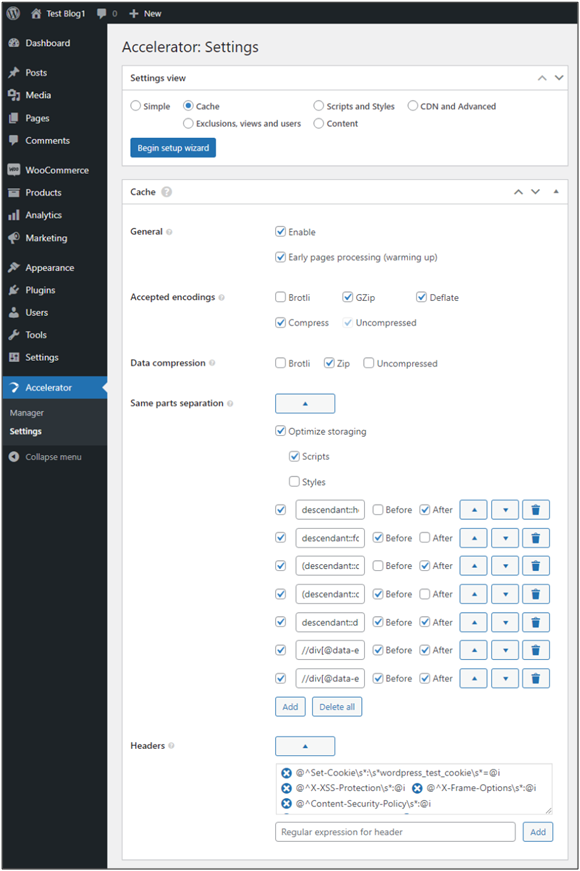One of the most important settings blocks for the WordPress cache system.

General#
-
Enables or disables the whole WordPress cache system. Note that WordPress content optimization is controlled by the ‘Enable content processing’ option independently.
- Early pages processing (warming up)
When pages are revalidated or deleted, they will be re-optimized immediately, not just the first time they are accessed.
Accepted encodings#
Here can be specified the encodings in which the server will serve the content. ‘Uncompressed’ is always on because this is required by the data transfer standard.
- Brotli
- GZip
- Deflate
- Compress
- Uncompressed
Data storing#
Compression#
- Brotli
If there is enough hosting space, then the data can be stored in this compressed form, which will slightly speed up the delivery of content if the request came with the same compression.
- Zip
If the request came with GZip, Deflate or Compress encoding, then the content will be served without re-encoding as quickly as possible. Also, compression saves space for cached data.
- Uncompressed
If there is enough hosting space, then the data can be stored in uncompressed form, which will slightly speed up the delivery of content if the request also came without compression.
- Use compression for assets
Storing assets in compressed state to provide faster server response. Can be turned off if there is some conflict between server compression.
Directory levels#
By default, all hashed items like ‘00112233445566778899aabbccddeeff’ are stored under root directory. This option allows to store items in subdirectories to minimize files count in one directory. So, entering 1:2 parameter will convert ‘00112233445566778899aabbccddeeff’ to ‘0/01/12233445566778899aabbccddeeff’.
Same parts separation#
It’s the settings for fragmentation technology. The content is divided into parts, which are stored independently and allows to select the parts that are identical in content. This contributes to significant savings in cache storage space on the hosting, since many pages have the same parts, such as header, footer, comment block, etc.
- Optimize storaging
Enables this mode.
- Separators
- Enable
Enables/disables a specific separator for easy customization, so as not to delete an element.
- Element(s) XPath selector
One or more elements can be specified through an XPath selector.
- Before
Split content before the element.
- After
Split content after the element.
-
The division into parts can be checked with the ‘Enable’ debugging option enabled and loading the checked page with the ?seraph_accel_proc=1 parameter. In the page HTML code, we need to search for special separating elements <!-- seraph-accel-cont-sep --> and check their location in accordance with the specified settings.
Headers#
These settings allow to cache particular headers, e.g. cookies, by adding them as a regular expressions patterns. If the pattern matches the header will be added to the page’s cache. It can be added multiple patterns at once by placing each on new line.
Here is the pattern example for a header with cookie wordpress_test_cookie which is already added by default:
@^set-cookie\s*:\s*wordpress_test_cookie\s*=@i